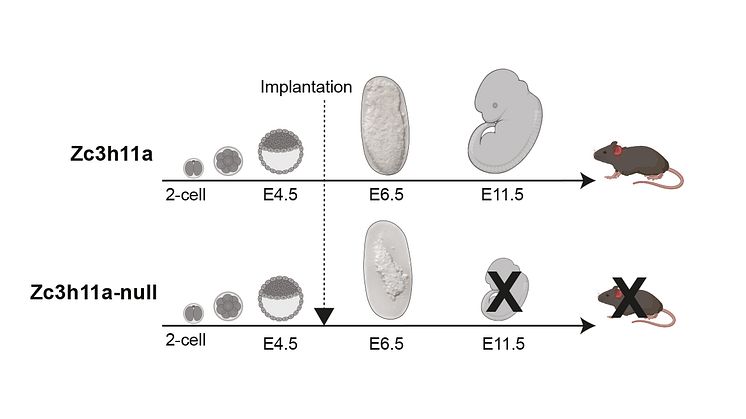
Press release -
A pro-viral human protein is critical for embryo development
A new study, led by scientists at Uppsala University and INRAE/Université Paris-Saclay, has discovered that the pro-viral host protein ZC3H11A has a critical role to maintain embryo viability during early development. The study has uncovered a previously unknown function of ZC3H11A in the intricate process of embryonic growth and highlights its impact on development. The paper is published in the journal PNAS.
Peer-review/Experimental study/Animals
With over twenty thousand genes in the human body, the physiological functions of many genes remain elusive. A previous study from the same team identified ZC3H11A (abbreviated as ZC3) as a pro-viral protein because it is required for efficient growth of several human nuclear-replicating viruses such as HIV. Hence, the ZC3 protein has emerged as a promising therapeutic target for the development of anti-viral agents against medically significant human viruses. In the current study, the team has uncovered an additional function of ZC3 during a specific time-point in early embryo growth in mice. Interestingly, upon deleting ZC3 in adult mouse tissues, no apparent defects were observed. This finding indicates that ZC3 possesses distinct roles depending on the developmental stage.
The current study demonstrated that ZC3 plays a pivotal role in regulating the expression of metabolic genes crucial for the metabolic changes that occur in embryos around implantation. The disruption or absence of ZC3 results in complete lethality of mouse embryos and it is likely that inactivation of this gene is lethal in other mammals including humans. This finding emphasises the indispensable nature of ZC3 in orchestrating the metabolic processes essential for embryo survival and development.
“The aim of the study was to establish a ZC3 mouse model to study its role in virus replication. It was surprising when I realised that mouse embryos lacking a functional ZC3 gene did not survive,” explains Shady Younis, who led the study together with Leif Andersson at the Department of Medical Biochemistry and Microbiology, Uppsala University. We therefore decided to study the ZC3 knock-out mouse embryos at various developmental stages in order to pinpoint the precise time at which ZC3 plays a vital role.
Using RNA-sequencing and proteomics assays, the research team made a significant discovery regarding embryos lacking ZC3 as they observed severe defects in metabolic regulation in these embryos.
“We collected mouse embryos at early stages of pregnancy with the aim of finding ZC3-null embryos for detailed characterisation,” says Alice Jouneau, an embryologist from INRAE/Université Paris-Saclay and a co-author of the study. “We observed a fraction of embryos displaying morphological defects. Subsequent DNA genotyping confirmed that these embryos indeed lacked the ZC3 gene.”
Undeterred by the embryonic lethality associated with ZC3 deletions, the researchers began studying the impact of ZC3 deletion in adult organs. To achieve this, they developed an inducible mouse model that allowed them to knock out ZC3 specifically after birth. The results of this study revealed a surprising outcome, as complete inactivation of ZC3 in mouse tissues did not exhibit any noticeable effects on cell growth or viability. The fact that ZC3 depletion in adult tissues did not result in any noticeable clinical consequences suggests that an anti-viral therapy based on inactivation of ZC3 may not have significant side effects.
“ZC3H11A stands out as one of the many highly conserved genes across vertebrates but with a poorly described function. This study shed light on the functional significance of ZC3 as one of the factors critical for normal embryo development,” says Leif Andersson, Professor of Functional Genomics at Uppsala University. “The fact that ZC3 does not appear to be critical for cellular growth after birth but for replication of multiple medically important viruses makes it an interesting target for the development of new anti-viral therapies.”
Reference: Younis et al. (2023) Ablation of ZC3H11A causes early embryonic lethality and dysregulation of metabolic processes. Proc Natl Acad Sci USA, doi.org/10.1073/pnas.2216799120
For more information, contact:
Professor Leif Andersson, Department of Medical Biochemistry, Uppsala University; Texas A&M University; SLU - Swedish University of Agricultural Sciences, , phone +46-704250233, e-mail: leif.andersson@imbim.uu.se
Dr. Shady Younis, Department of Medicine, Stanford University, phone: +1-6503536530, e-mail: syounis@stanford.edu
Image 1: Schematic illustration demonstrating different stages of embryo development, highlighting the time-point of implantation with an arrow. Embryos lacking the ZC3H11Aa protein are unable to survive after implantation, resulting in their degeneration.
Topics
Categories
Founded in 1477, Uppsala University is the oldest university in Sweden. With more than 50,000 students and 7,500 employees in Uppsala and Visby, we are a broad university with research in social sciences, humanities, technology, natural sciences, medicine and pharmacology. Our mission is to conduct education and research of the highest quality and relevance to society on a long-term basis. Uppsala University is regularly ranked among the world’s top universities. www.uu.se

